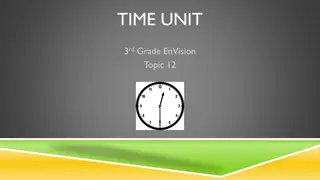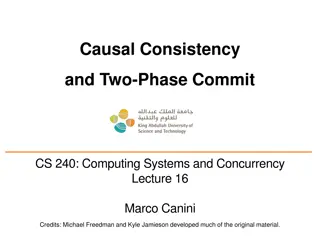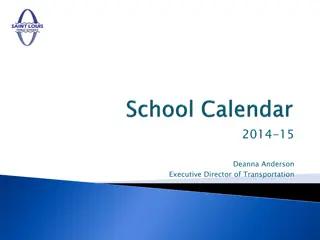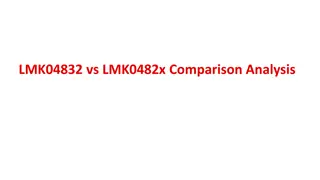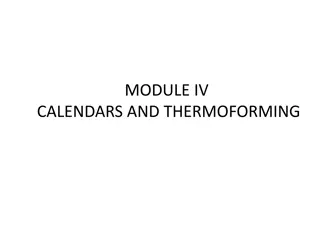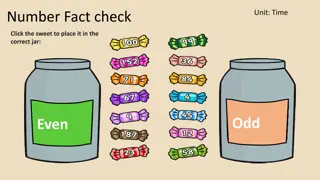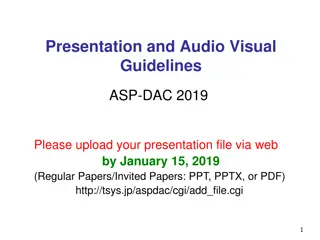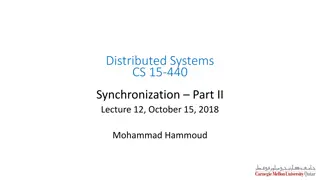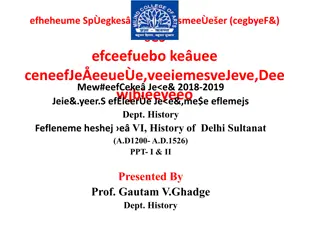Fun with Calendars and Clocks
Explore the world of calendars and clocks with activities, questions, and fascinating facts. From learning the number of days in different months to understanding how the hands of a clock work, dive into the concepts of time and organization. Engage in interactive tasks like marking birthdays, national holidays, and identifying specific times on clock faces. Discover the intricacies of hours, minutes, and hands on a clock as you unravel the mysteries of timekeeping.
Uploaded on Sep 19, 2024 | 0 Views
Download Presentation

Please find below an Image/Link to download the presentation.
The content on the website is provided AS IS for your information and personal use only. It may not be sold, licensed, or shared on other websites without obtaining consent from the author.If you encounter any issues during the download, it is possible that the publisher has removed the file from their server.
You are allowed to download the files provided on this website for personal or commercial use, subject to the condition that they are used lawfully. All files are the property of their respective owners.
The content on the website is provided AS IS for your information and personal use only. It may not be sold, licensed, or shared on other websites without obtaining consent from the author.
E N D
Presentation Transcript
Number of days in different months 30 days has September, April, June and November All the rest have 31 And February s great with 28 or 29.
Now lets answer some Questions (Refer to 2020 calendar) How many days are there in the year 2020? How many weeks are there in this year? Which day is Christmas in 2020? What date is on the third Sunday of May? How many Mondays are there in the month of September? Find out how many days were there in 2019? Is it different from 2020? If yes why?
Activity Create a calendar and.. Fill the Birthday of your parents with Yellow colour Mark all national holidays with blue colour. Circle all the fifth Sundays.
There are 24 hours in a day. There are 12 numbers on the face of a clock. There are 2 hands in a clock. The long hand measures minute. The short hand measures hours. I know When long hand is at 12 it s O clock When minute hand is 6 it s half past
Activity Draw Hour hand and minute hand in the given clocks to show the time 7: 30 11: 30 9 o clock
Units of time....(Hours and Minutes) As you can see the clock face has 12 big units and 60 small units. Each small unit is called a MINUTE and each big unit is called an HOUR When the minute hand takes one round and moves through all these 60 small units (minutes) its call an HOUR So, an Hour is equal to 60 minutes
How many minutes will the minute hand take to move from: * 12 to 3 * 8 to 11 * 4 to 7 Can you tell me how many rounds does the hour hand complete in a day? Write two units of time.
What the time will be if the minute hand is against any mark numbers other than 6 or 12 ?
If the minute hand is on the right hand side (12-6) we say past the hour If the minute hand is on the left hand side (6-12) we say to the hour
Example... The hour hand is between 1 and 2 The minute hand is at 5 (Right hand side) Time : 25 minutes past 1 (1:25) The hour hand is between 4 and 5 The minute hand is at 8 (left hand side) Time : 20 minutes to 5 (4:40)
Draw hour hand and minute hand to show the following time on the clock Quarter to 8 Quarter past 6 Write the following times in numbers || Write the following times in words 20 minutes past 5 Quarter to 9 12:10 5:40
Converting Units of Time.... 1 Day = 24Hours 1Hour = 60 Minutes 1 Week = 7 Days 1 Year = 12 Months 1 Year = 52 Weeks 1 Year = 365 Days
Days into Hours When we convert days into hours we multiply the number of days by 24 e.g.
Hours into Minutes When we convert hours into minutes we multiply the number of hours by 60 e.g.
Hours and Minutes into Minutes When we convert hours and minutes into minutes we multiply the number of hours by 60 and add to it the number of minutes. Ex: How many minutes are in 6 hours 10 minutes? 1 Hour = 60 Minutes 6 Hours = 6 x 60 mins = 360 mins 360 mins + 10 mins = 370 mins 6 hours 10 minutes = 370 minutes
The 24 hours of the day is divided into two parts They are A.M. and P.M.
The first part of the day goes from midnight to day. It is the morning We call the time between midnight and Noon as A.M.
The second part of the day goes from noon to midnight . It is the afternoon and evening. We call the time between noon and midnight as P.M.
P.M. is A.M. is The Last twelve hours of the day The abbreviated word for Post Meridiem Another way to say P.M. is Afternoon, Night and after midday The first twelve hours in a day The abbreviated word for Ante Meridiem Another way to say A.M. is morning, midday and before noon We do not use A.M or PM with 12
There are 12 months in a year. January, March, May, July, August, October and December have 31 days. April, June, September and November have 30 days. February is the shortest month of the year. One day equal to 24 hours. The long hand of the clock measures minute and the short hand measures hour. One hour is equal to 60 minutes. If the minute hand is on the right hand side we say past the hour. If the minute hand is on the left hand side we say to the hour.
When we convert days into hours we multiply the number of days by 24. When we convert hours into minutes we multiply the number of hours by 60. When we convert hours and minutes into minutes , we multiply the number of hours by 60 and add to it the number of minutes. 12 midnight to 12 noon is A.M. 12 noon to 12 midnight is P.M.




